Who we are and our history in North Carolina

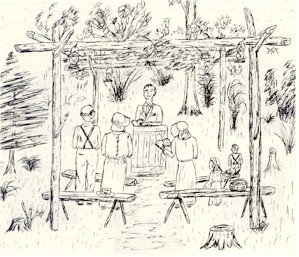
Bethesda Methodist Protestant Church, the subject of this sketch, is located in Davidson County, N.C. seven miles north east of Lexington, N. C. and three miles east of Welcome, N. C. at the junction of Ridge Road and the road leading from near the home of J. B. Wagner in a southwestern direction toward Lexington. It had its beginning about one mile east of its present location under a brush arbor on the farm of the late Alexander Evans. It had its conception in the mind of Rev. J. H. Pegram who was at the time pastor of Shiloh Methodist Protestant Church, which is located about six miles west of Lexington in the direction of Yadkin College. Alexander Evans had been reared near the Shiloh Church and visiting the old home community during a revival, was converted. Rev. Pegram, ready to further advance the Kingdom and at the same time better care for the new convert, planned through Mr. Evans to have a preaching appointment in the community of the latter if it were found desirable on the part of the community. There was little trouble in finding and planning for this preaching place for the people gladly gave of their time and efforts to build a brush arbor in the woods of Mr. Evans and under this tabernacle the first service of Bethesda was conducted. The people were glad to have a place of worship even though it was temporary for the closest church was at least three miles away, and with travel of that day this was a long distance to attend church.
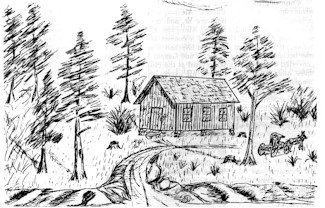
Plans were soon put into effect to erect a small building on the grounds of the present location. Joseph Clodfelter and Alexander Evans found themselves in the woods sawing the frame for the building, and most of this framing is to be found in the present church building. One and one half acres of ground, which is the present location was donated by Joseph Clodfelter, who also pledged $25.00 in cash. With the exception of one load of shingles which was hauled by David S. Leonard, who afterwards became one of the most faithful of the church, the hauling was done by Alexander Evans. Money was contributed by friends to help on the building fund but there are no records to show just how much the building cost. Andrew Craver was the builder, but whether he did the work by contract or by day labor is not known. Neither is it known as to what was paid for labor and how much of the cost of the church was invested in material. It is perhaps safe to suppose that Mr. Craver was employed as a leader or foreman of the work while others contributed free labor. When the church was completed, it was found that there was a debt of about $100.00 which was assumed by Joseph Clodfelter, who by this time had become the outstanding leader of the church. His interests and activities now stood out in great contrast to his hesitating attitude when he insisted on taking one of the back seats in the old brush arbor. Even though the church was not large it probably took some time to build it as perhaps all work was done by hand. Perhaps the building was under process of erection most of the year, the details of which are lost to memory and are not given by any record. It is known however that the little church in the pine woods by the cross roads was completed and clear of debt by November 21, 1870 for on this date the little church was dedicated to the Glory of God. This must have been handed down without being forgotten. Who preached the first sermon in the new church or who conducted the dedication service is not known but it is natural to suppose that Rev. J. H. Pegram the first pastor conducted these services.
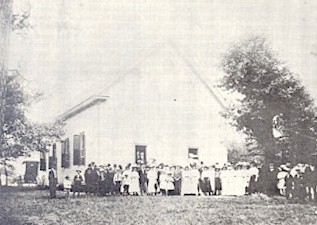
About 1886 the good ladies of the church, under the leadership of Mrs. I. Y. Clodfelter and Mrs. J. D. Curry found means to purchase material for curtains for all the windows and for carpet for the aisle, the floor around the pulpit, and for the pulpit rostrum. At the same time the men by means of free labor changed the style of the pulpit and rostrum. The pulpit was considerably reduced in size. Out of the materials of the old one, one was built which was about one foot higher than the main floor, and was so styled that the front line followed the line of a segment of a circle. There was never a chancel rail. The pulpit and the board that served as the riser or elevation to the rostrum was painted the color being that of walnut. This was the only paint ever used on the old building. Until this time no carpet had ever graced any part of the floor. The second building, a structure thirty-five feet wide and fifty-six feet long was erected during the years 1895- 1896. Most of the framing that was hewn in the woods by the hands of Joseph Clodfeltel and Alexander Evans for the original building was retained in the second and is in good condition to this day. Indeed the framing of the old, except that of the roof and the sleepers. was never torn down. With a thought that it would be an economic saving, the old building was cut in half from front to back and the halves of the old church were so located as to become the two ends of the new. Whether this was a real saving or not no one will ever know, but it does mean that most of the frame of the old building is still in good preservation and doing good service in the new. The new building was largely built from voluntary contributions and free labor. There was never an appointed collecting agency or a building committee. The agreement among the brethren was for all to work together. It is the exceptional case where a fine piece of work was done without an organization. "The people had a mind to work" and they were "Co-workers with God". The work was done as the people found time and had money to invest. Friends, neighbors, and brethren from other churches and denominations responded liberally with time and means. The work was done from start to finish with little or no unpleasant feeling on the part of anyone. Happiness prevailed throughout the entire progress of the work and when all the work was done they were glad to say, , 'I was glad when they said unto me, 'Let us go into the house of the Lord'," It would be difficult to find a church building project that was carried on with finer harmony than that of the building of Bethesda Church. There are no records to show what was the cost of this building. Indeed it is doubtful if anyone even as much as estimated the cost. It was not so much counting the cost as it was persistent effort, working by sight and by faith until the work was done and the church was completed. Rev, J, R. Walton served as pastor the year the building was begun and Rev. J. H. Stowe was pastor when it was completed.
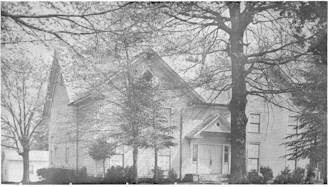
The second building served well the needs of the church until 1924, when the people felt the need of more room and better facilities. At this time an addition 16 feet wide and extending the entire 56 feet length of the church was erected on the west side of the building. The floor plan of the church was so changed that the pulpit was placed in the east side of the church instead of the south. The entrance and front of the church was made to be in the west side instead of the north. The choir loft was built in the north east corner of the building to the right of the pulpit. The new addition of the building was built two stories high and cut into class rooms but made to open into the main part of the church to accommodate large audiences. A nice pastor's study was built just back of the pulpit. The pastor's study has since been rebuilt and made into a number of classrooms for Church School purposes. Like other building projects of Bethesda Church the remodeling of 1924 was done by free labor and voluntary contribution. G. Ed Wagner, the Chairman of the Board of Trustees and a builder of years of experience, was the foreman of the work while a number of experienced mechanics in the church as well as those not members of this church responded with their services. Here too, as at other times when building was being done, harmony and good will prevailed
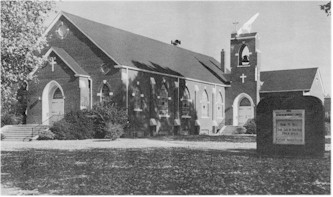
The cornerstone was laid during the homecoming of 1952 by Dr. George Clemmer, the District Superintendent, with 330 persons in attendance. Brother Hornbuckle had the honor of preaching the first sermon in the new building on the challenging subject: "To Make Bethesda A Great Church." The estimated total cost for the building was $68,916.00 exclusive of donated labor. It was completely debt- free March 17, 1955 less than four years after construction was begun. That first home- coming in the new church brought mixed feelings to many of the older members. This building replaced the wooden structure which had contained timbers from the original structure built in 1869-70. The first homecoming in the new church in August 1953, marks the beginning of a new direction for Bethesda. The people of the church had rushed to completion the new building so that it might be occupied at the homecoming service. And so on this August 9th, over 300 persons were on hand for Sunday School with still others coming in for the worship service. Miss Susie Latham was organist for the day, the first hymn was " All Hail The Power Of Jesus Name." Otha Everhart was superintendent of the Sunday School. After the sermon by the pastor, the Rev. J. P. Hornbuckle, a bountiful dinner- on-the-grounds" was enjoyed by a throng of people from many different places. In the afternoon there was a fellowship singing, led by the Rev. Russell Montford, a memorial service led by Miss Naomi Brinkley, then Harvey Berrier brought the message of the after. noon. A very full day was completed that night when the Rev. Leon Stubbs preached the first revival in the new building.
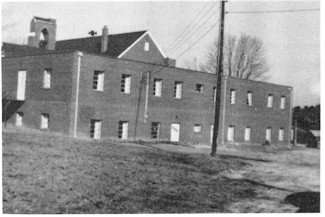
As the Sunday School grew, more space was needed. In 1958, an educational building was built. Now the children were provided with 12 class rooms, one for each age group. Mrs. Numa Leonard was now superintendent. The need for an organized Worker's Council of children's teachers was seen, as these 12 classrooms needed furnishing. The church provided the chairs and the Children's Division furnished the other items. Suppers were held to provide money. Many donations and work were received from interested folks of the church. Soon each room had tables, bulletin boards, drapes at the windows, and tile on the floor, etc. A library was started and continues to grow. Books are added by interested friends in honor or memory of someone. A book is placed in the library by the division in case of a death of a member. Mrs. Naomi Ellerbe and Mrs. Rober Wooten were the first librarians. Faye Wooten also assisted. Jane Wagner is presently serving in this capacity. An office in a hallway between the educational building and church was soon equipped with a desk, typewriter. duplicator, mimeograph machine, paper cutter, and other small items to make up a complete office. Mrs. Rueben Essick was elected secretary . Miss Edna Hege was elected secretary of the rolls.
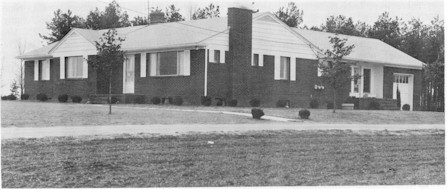
Only two years later, the church became the larger half of a two-point work called Bethesda-Ebeneezer and a parsonage was rushed to completion for the Rev. Coriless Hanson, a member of the Florida Conference, who served Bethesda-Ebeneezer while at- tending Duke Divinity School. Following the $75,000 church building so closely with a $20,000 parsonage would seem to have been an impossible task, but this was the new Bethesda. and it was done. The final debt on the church was paid in tine for the dedication of the church on Homecoming Day, August 14, 1955. The parsonage was completed in the Fall of 1955 and the report as of June 30, 1956 showed that a total of $15,087.50 had been spent with an estimated $5,000 in free labor which was not included in the above figure. The parsonage is a lovely B-room brick structure with a full basement, oil furnace heat. located on a beautiful 2 acre lot about 1/2 mile above the church overlooking the valley in which the church lies. The statement by building fund treasurer. Hinley Truluck, in June 1956 when there was still a $11.000 debt on the parsonage is a classic and is included here for that reason. "I have bills and cancelled checks to substantiate the building fund report and if at any time anyone desires to review same please feel free to ask me and I will make the records available.
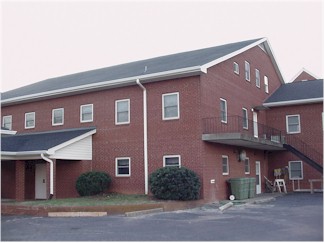
On August 15, 1968 work began on the three story educational building and the Fellowship Hall. The work was completed and the Fellowship Hall was used for the first time on November 7, 1969.
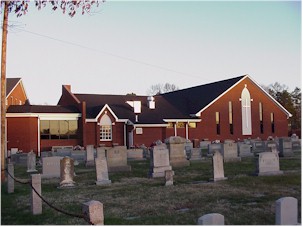
Our community has experienced tremendous growth during the past decade. Our schools are operating at capacity and even more students are expected in the years ahead. This was the reason that Bethesda United Methodist Church decided to build a Family Life Center. Below are some of the needs that can potentially be met through this new facility. A fellowship area to comfortably serve our congregation for church meetings, meals, dramas and other large group activities. Space for sports and exercise programs such as basketball, volleyball, aerobics, and other activities for all age groups. Meeting space for educational workshops and seminars for church members and others. Space for possibly an After School program and Mother's Morning Out. A commercial grade kitchen to meet present and future needs. A nursery facility located in the center to serve our young parents. A parlor for use for small groups, circle meetings, wedding activities, and deceased family visitation.